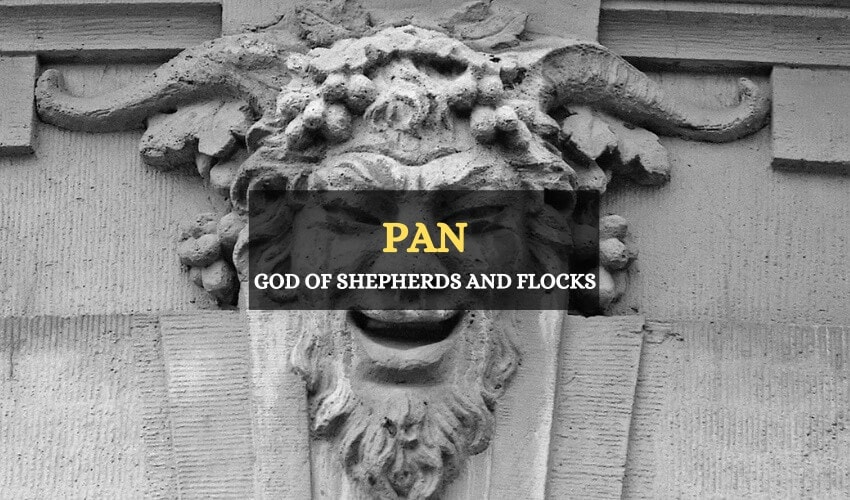
Table of Contents
In Greek mythology, the pastoral god Pan (Roman equivalent Faunus) stands out for his unique build and his relation to music. His myth involves several amorous encounters, most notably with Syrinx. Here’s a closer look.
Origin and Description of Pan
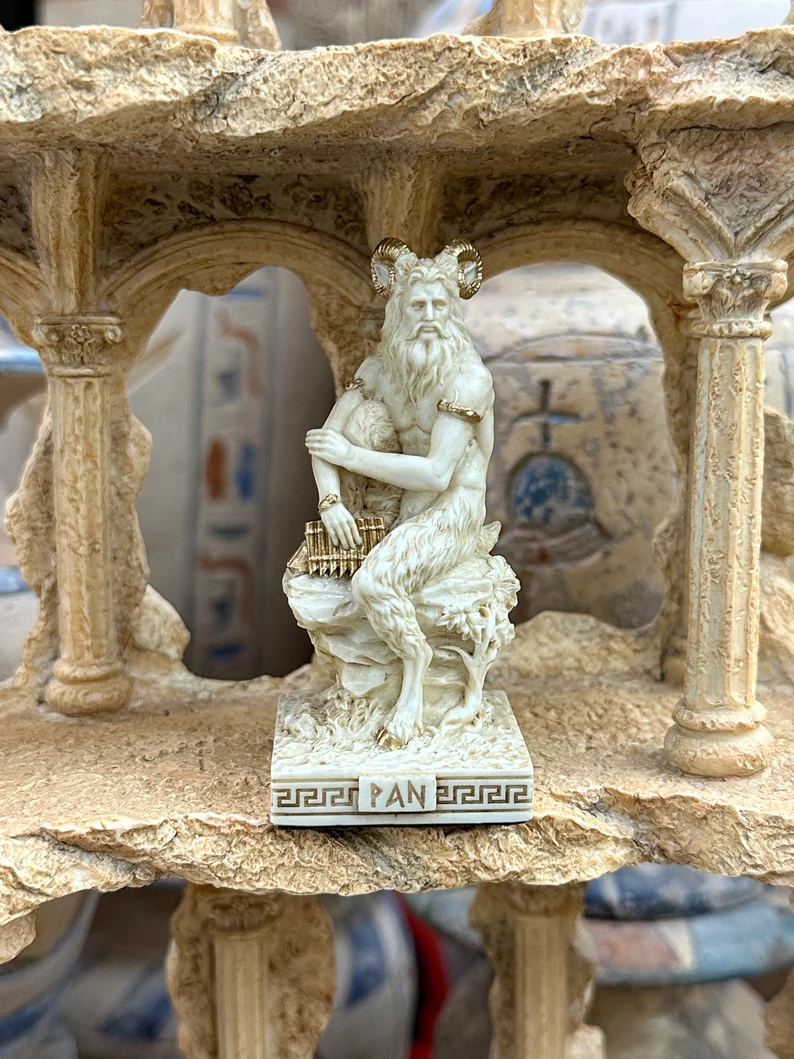
In Greek mythology, Pan was the son of Hermes, the herald of the gods and depending on the myth, his mother was Aphrodite, Penelope or Dryope.
Pan was the god of shepherds, hunters, the flocks, the mountain forests and meadows. He was mainly concerned with flocks and cattle. He lived in the caves of the mountains of Arcadia, and the shepherds of the region were his main worshippers. This made him a pastoral god.
In contrast to most gods, Pan was not a human-like deity. Pan was a half-goat half-man creature, with a resemblance to a satyr or a faun. He was born not as a baby but as a bearded man with the lower limbs of a goat and horns on his head. His unique look amused the gods, for which they decided to name him Pan, which means all in ancient Greek.
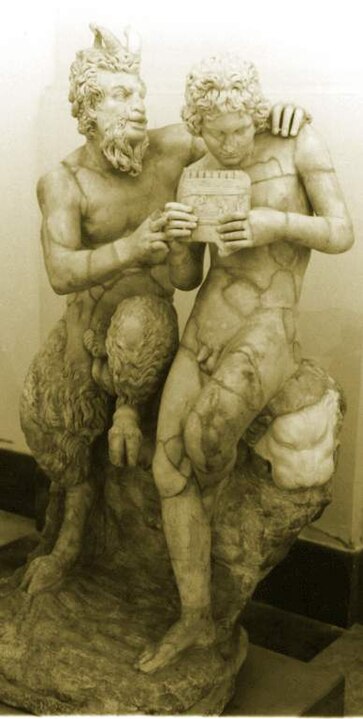
Pan’s Romantic Affairs
Several myths involving Pan relate to his undying love for nymphs and other minor female deities, which is why he is also associated with sexuality.
Pan and Selene
Selene, the Titan goddess of the moon, was another object of Pan’s affection. Selene was known for her radiant beauty which rivalled the light of the moon she personified. Unlike his pursuits with the nymphs, Pan used a different approach to win over Selene. He wrapped himself in a white sheepskin, disguising his rustic appearance. This made him appear as a radiant and beautiful creature in the moonlight, which charmed Selene. Pan eventually won over Selene’s heart, and they shared a romantic relationship.
Pan and Echo
Echo was an Oread nymph who resided on Mount Cithairon. She was known for her chatter and her habit of always having the last word. Pan saw Echo and was captivated by her beauty and grace. However, Echo did not reciprocate Pan’s feelings and rejected his advances. Enraged by this rejection, Pan incited his followers, the shepherds and goatherds, to attack Echo. They tore her to pieces and scattered her remains. However, Gaia, the goddess of Earth, received Echo’s remains, and her voice continued to live on, repeating the last words of others, hence the modern term “echo”.
Pan’s most famous romantic interest was the nymph Syrinx, which would also lead to the creation of his famous symbol – the pan flute.
Pan and Syrinx
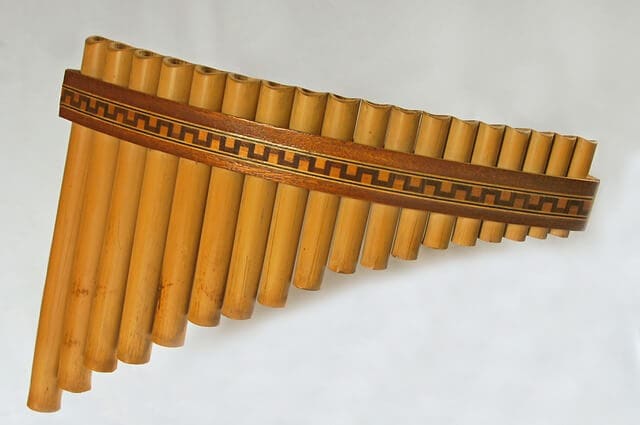
Syrinx was a beautiful nymph and one of the many nymphs of the goddess Artemis. Like her goddess, she was focused on remaining pure and virginal. So, when Pan made advances, she kept rejecting them. When he started pursuing her, Syrinx ran away from him.
Finally, she came to a river and knew that she couldn’t run away from him, so she beseeched the river nymphs to help her. They immediately transformed her into a reed. Pan sighed on the reeds, and they produced a beautiful sound. When the god realized this, he cut the reeds to different lengths and attached them together in order of length, creating the first panpipes in the world. To honor the late nymph, he called it Syrinx. The instrument would go on to be one of the cultural symbols of Arcadia.
Pan became such an expert player of the syrinx that he even challenged Apollo to a contest to see who the better musician would be. Pan lost.
Pan and Pitys
Pitys was another nymph who caught Pan’s eye. Pan chased Pitys through the forest, expressing his love and desire for her. However, to escape Pan’s relentless pursuit, she called upon the gods for help. In response, they turned her into a pine tree. Thus, Pitys was able to escape Pan’s advances but at the cost of her own freedom.
Pan’s Shout
Since Pan was a shepherd, he worked until noon and then took a nap. In the myths, Pan’s nap was sacred, and he loved them as much as he loved the nymphs, so anybody who dared to disturb him while he was napping would suffer his anger.
When somebody awoke him, he would emit a shrill, loud shout that caused fear and distress to everybody who listened to it. This feeling came to be known as panic, a word that derives its roots from Pan.
The myths say that the god Pan assisted the Athenians in the battle of Marathon against the Persians with his shout. For this, Pan had a strong cult in Athens.
Below is a list of the editor’s top picks featuring the statue of Pan.
Pan’s Role in Greek Mythology
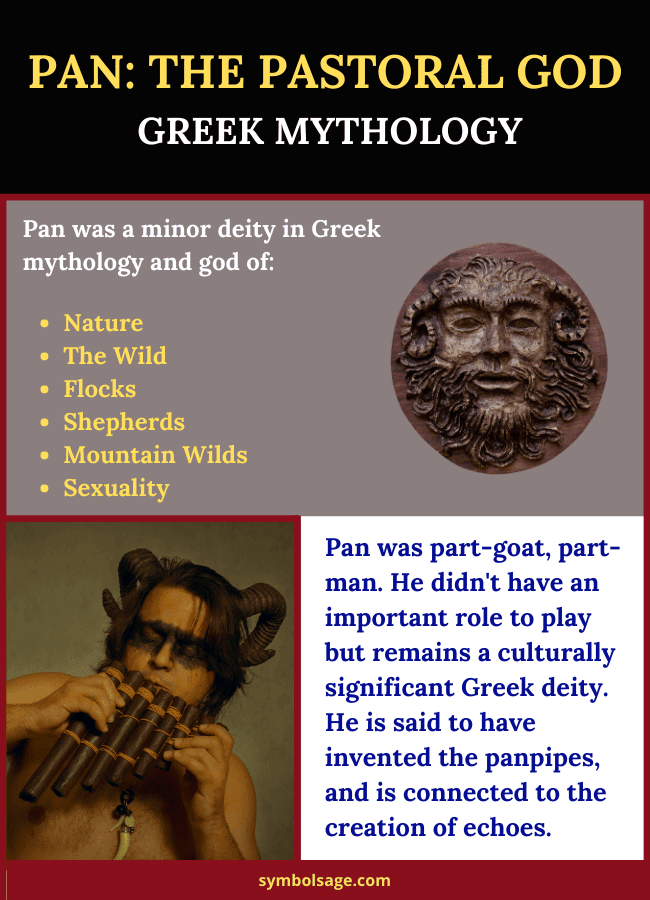
Pan was a minor figure in literature, and his deeds in the Greek tragedies are scarce. Since he was the protector of shepherds and hunters, these groups worshipped him and offered him sacrifices. Pan was a pastoral god and was associated with other deities of the same nature, such as Aegipan.
Pan was also connected to sexuality and lust, and thus a part of Dionysus‘ Bacchae. He did not have a specific role, and most of his stories talk about what he did daily in Arcadia. Pan worked in the fields in Arcadia, chased down nymphs, and took his naps.
The Death of Pan
Pan is the only god who dies in Greek mythology, which makes him a unique deity. The story of Pan’s death, as reported by the ancient Greek writer Plutarch, goes as follows:
Thamus was sailing a ship near the islands of Paxi in the Ionian Sea. Suddenly, he heard a mysterious voice coming from the shore. The voice instructed him that, upon his arrival at the place called Palodes, he should shout out that the great god Pan is dead.
When Thamus reached Palodes, he did as the voice had instructed. He shouted from his ship that Pan was dead. The words echoed across the water and to the people on the shore, who responded with a great cry of mourning.
This story, despite being relatively brief, has spurred much speculation and interpretation. Some see it as a symbol of the transition from the age of the ancient pagan religions, represented by Pan, to the new age of Christianity. Others see it as representing the death of nature and the old, wild world, which Pan also represented. It’s worth noting, however, that even after this proclaimed “death”, Pan continued to be worshipped and revered in many rural areas, and he has had a significant influence on modern neo-pagan and nature-based spiritual movements.
Pan God Symbols
Pan, the Greek god of nature, shepherds, and flocks, is associated with several symbols that reflect his dominion and attributes. Here are some of them:
- Goat: The goat is a primary symbol of Pan because, according to Greek mythology, he is portrayed as a satyr, which is half-human and half-goat. This association is a direct reflection of Pan’s characteristics, with his lower body depicted as that of a goat, complete with fur, hooves, and horns. The goat represents not only Pan’s physical form, but also his primal, unrestrained nature. Goats were often used in sacrificial offerings to gods, including Pan, reinforcing this symbol.
- Pan Flute (Syrinx): The Pan flute is another significant symbol for Pan. This connection comes from the myth where Pan fell in love with the nymph Syrinx. To escape Pan’s advances, Syrinx prayed to be transformed into a reed. Pan, not knowing which reed Syrinx had become, cut several reeds and joined them side by side in decreasing lengths to make a musical instrument, which became known as the Pan flute or Syrinx. This instrument symbolizes Pan’s longing and his connection to music and pastoral life.
- Shepherd’s Crook: Pan is known as the god of shepherds and flocks in Greek mythology. As such, the shepherd’s crook—a long and sturdy stick with a hook at one end—is a fitting symbol for him. Shepherds use this tool to manage and protect their flock, just as Pan is seen as a guide and protector. This symbolizes Pan’s pastoral origin and his dominion over nature and animals. It reinforces the idea of his role in guiding and protecting, both in a physical sense (protecting flocks) and a spiritual sense (guiding humans through panic and fear).
Influence of Pan
Pan appears in several art depictions in the 18th and 19th centuries, either playing the syrinx or chasing a nymph. As a nature god, Pan became popular during this time, and many festivals were organized around Pan.
There is also some connection of Pan to Neo-Paganism and Satanism. Due to his goat-like build, people have connected Pan to some versions of Satan, which depict him also with the tail, horns, and legs of a goat. He’s also worshipped as a version of the horned god. These perspectives have little to do with his original Greek myth.
Facts About Pan God
Pan’s parents are Hermes and either Aphrodite, Driope or Penelope.
Yes, Pan’s siblings were the Satyrs, Laertes, Maenads and Circe.
Pan had several romantic interests, but the most important are Syrinx, Echo and Pitys.
Pan’s children were Silenos, Krotos, Iynx and Xanthus.
Pan’s Roman equivalent is Faunus.
Pan was a minor deity. He ruled over shepherds, flocks, the mountain wilds. He is also associated with sexuality.
Pan invented the panpipes, also known as the Syrinx, a musical instrument made of reeds of varying sizes, set together in descending order.
Pan’s hindquarters, legs and body were those of a goat, while his torso was that of a man. He also had goat’s horns on his head.
Pan is often depicted with the pan flute.
Pan’s sacred animal is the goat.
Pan lived in Arcadia.
In Brief
Pan was an important deity for the rural communities of Arcadia, and his cult spread from small groups of shepherds and hunters to the great city of Athens. Greek mythology always looks for explanations of the things we have on earth, and the god Pan has to do not only with the feeling of panic but also with echoes.











